
Understanding Jet A1 Flash Point: Safety First
At GLOBAL TERMINAL NETHERLANDS B.V, we understand the critical role of Jet A1 flash point in aviation safety. This key property determines how easily fuel vapors can ignite, affecting the safe handling and storage of aviation fuel.
In this post, we’ll explore the factors influencing Jet A1 flash point and the rigorous testing methods used to ensure compliance with industry standards. We’ll also discuss best practices for maintaining proper flash point levels, helping to safeguard aircraft operations worldwide.
Understanding Jet A1 Flash Point: A Critical Safety Parameter
Definition and Significance of Flash Point
Flash point stands as a cornerstone of aviation fuel safety, particularly for Jet A1. It represents the lowest temperature at which fuel vapors can ignite when exposed to an ignition source. For Jet A1, this temperature typically measures 38°C (100°F) or higher, as specified by ASTM International standards.
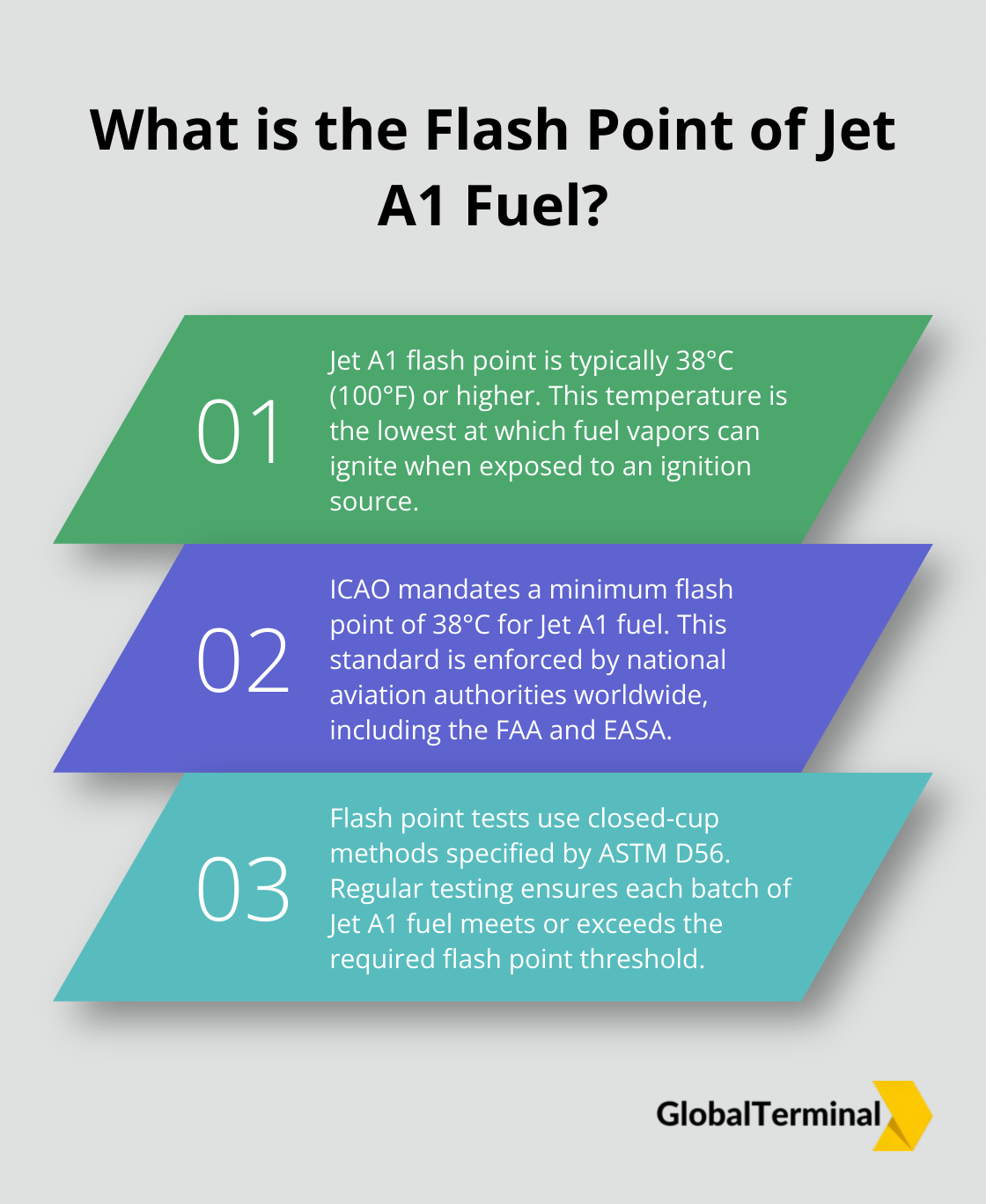
The flash point of Jet A1 directly impacts aviation safety. A higher flash point minimizes the risk of accidental ignition during fuel handling, storage, and transportation. This proves especially important in high-temperature environments or during emergencies where fuel spillage might occur.
The International Air Transport Association (IATA) emphasizes that maintaining the correct flash point prevents fuel-related incidents. Flash point is the measurement related to the relative flammability hazard of fuels in ground handling and flight storage and transfer.
Regulatory Standards for Jet A1 Flash Point
Strict regulations govern Jet A1 flash point to ensure consistent safety standards across the aviation industry. The International Civil Aviation Organization (ICAO) mandates a minimum flash point of 38°C for Jet A1 fuel. National aviation authorities worldwide echo this requirement.
In the United States, the Federal Aviation Administration (FAA) enforces these standards through rigorous testing protocols. Similarly, the European Aviation Safety Agency (EASA) maintains stringent oversight on fuel quality parameters, including flash point.
Flash Point Testing and Compliance
Industry professionals conduct regular flash point tests using closed-cup methods as specified by ASTM D56. This ensures that every batch of Jet A1 fuel meets or exceeds the required flash point threshold.
State-of-the-art testing facilities allow for the detection of even minor deviations from the standard. Quality control measures (such as those implemented by leading fuel providers) identify and prevent the distribution of off-spec fuel, demonstrating a commitment to aviation safety.
Impact of Environmental Factors
Environmental conditions can affect Jet A1 flash point. High ambient temperatures, for instance, can lower the effective flash point of stored fuel. To mitigate this risk, advanced temperature control systems in storage facilities prove essential.
As we move forward, it’s important to examine the various factors that can influence the flash point of Jet A1 fuel. Understanding these elements allows for better management and maintenance of this critical safety parameter.
What Influences Jet A1 Flash Point?
Chemical Composition: The Core of Flash Point
The chemical makeup of Jet A1 fuel significantly determines its flash point. The American Petroleum Institute highlights that the ratio of different hydrocarbon compounds in the fuel can cause flash point variations. A higher concentration of lighter hydrocarbons may lower the flash point, while heavier components tend to raise it.
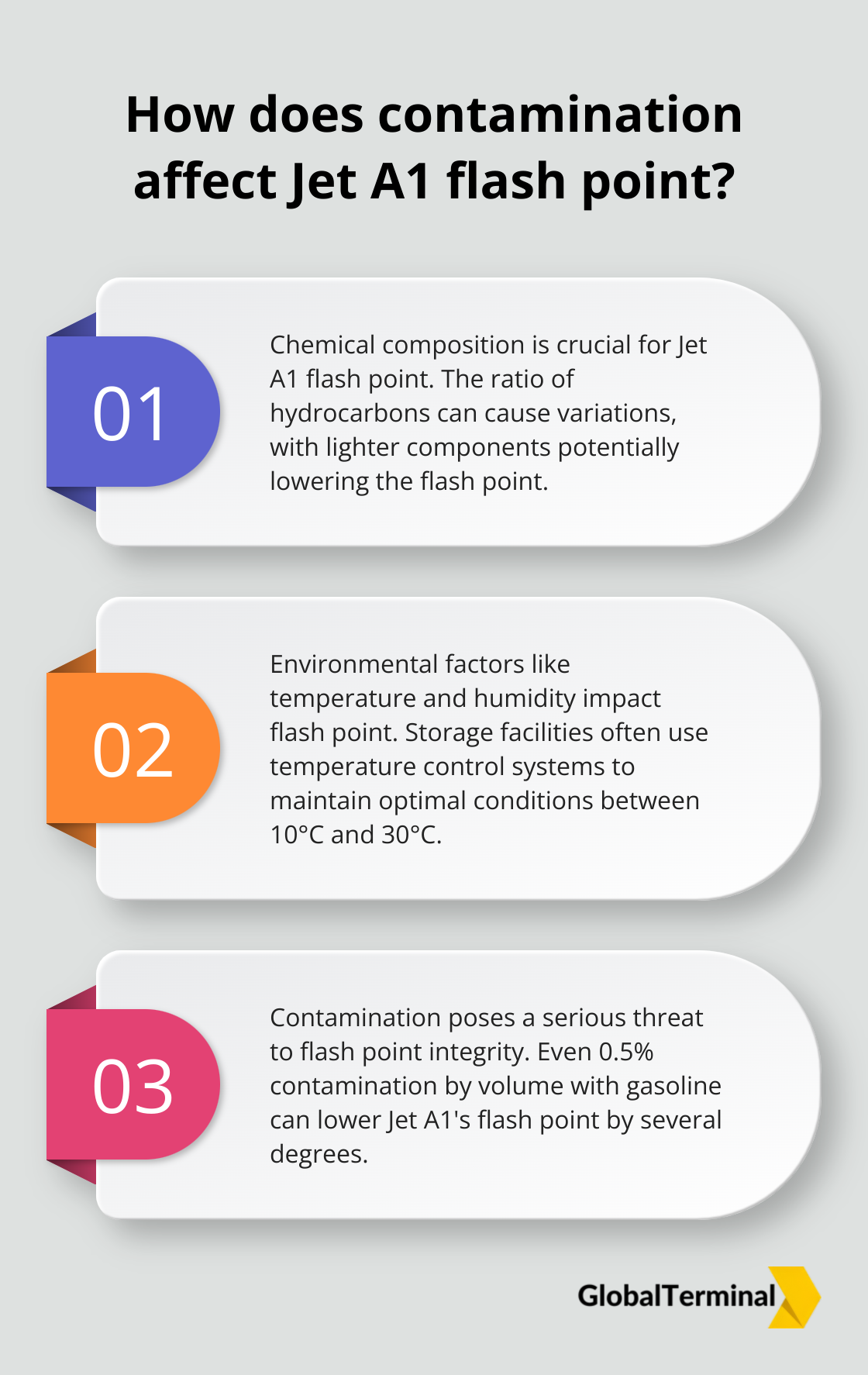
Fuel refineries must control the distillation process carefully to ensure the right balance of components. Modern refining techniques can produce Jet A1 fuel with flash points consistently above the required 38°C minimum.
Environmental Factors: Storage Challenges
Temperature fluctuations and humidity levels in storage facilities impact Jet A1’s flash point. The International Air Transport Association (IATA) points out that prolonged exposure to high ambient temperatures may lead to the evaporation of lighter fuel components, potentially altering the flash point.
Storage tanks at major fuel terminals often include temperature control systems to mitigate these effects. These systems maintain optimal conditions, typically keeping fuel at temperatures between 10°C and 30°C. Regular monitoring of storage conditions is essential, with data loggers recording temperature variations to ensure flash point stability.
Contaminant Impact: A Threat to Safety
Contamination poses a serious threat to Jet A1 flash point integrity. Water, particulates, or cross-contamination with other fuel types can all affect flash point characteristics. The Federal Aviation Administration (FAA) emphasizes the importance of rigorous filtration and water separation processes in maintaining fuel quality.
Industry studies show that even small amounts of contaminants can significantly alter flash point. For example, a mere 0.5% contamination by volume with gasoline can lower Jet A1’s flash point by several degrees, potentially bringing it below safety thresholds.
Fuel handlers employ multi-stage filtration systems and conduct regular quality checks to combat this issue. The American Society for Testing and Materials (ASTM) recommends daily water checks and weekly particulate inspections for storage tanks to maintain fuel integrity and flash point stability.
The aviation industry’s stringent safety standards demand close monitoring of these factors. Fuel providers must ensure that Jet A1 maintains its critical safety properties from refinery to aircraft. This vigilance sets the stage for the next critical aspect: the rigorous testing and monitoring procedures used to verify Jet A1 flash point compliance.
How We Test and Monitor Jet A1 Flash Point
Precision Testing Methods
The primary method for determining Jet A1 flash point is the Pensky-Martens Closed Cup Test (ASTM D93). This test consists of a closed-cup arrangement that contains any vapors produced and essentially simulates the situation. The temperature at which this occurs is recorded as the flash point.
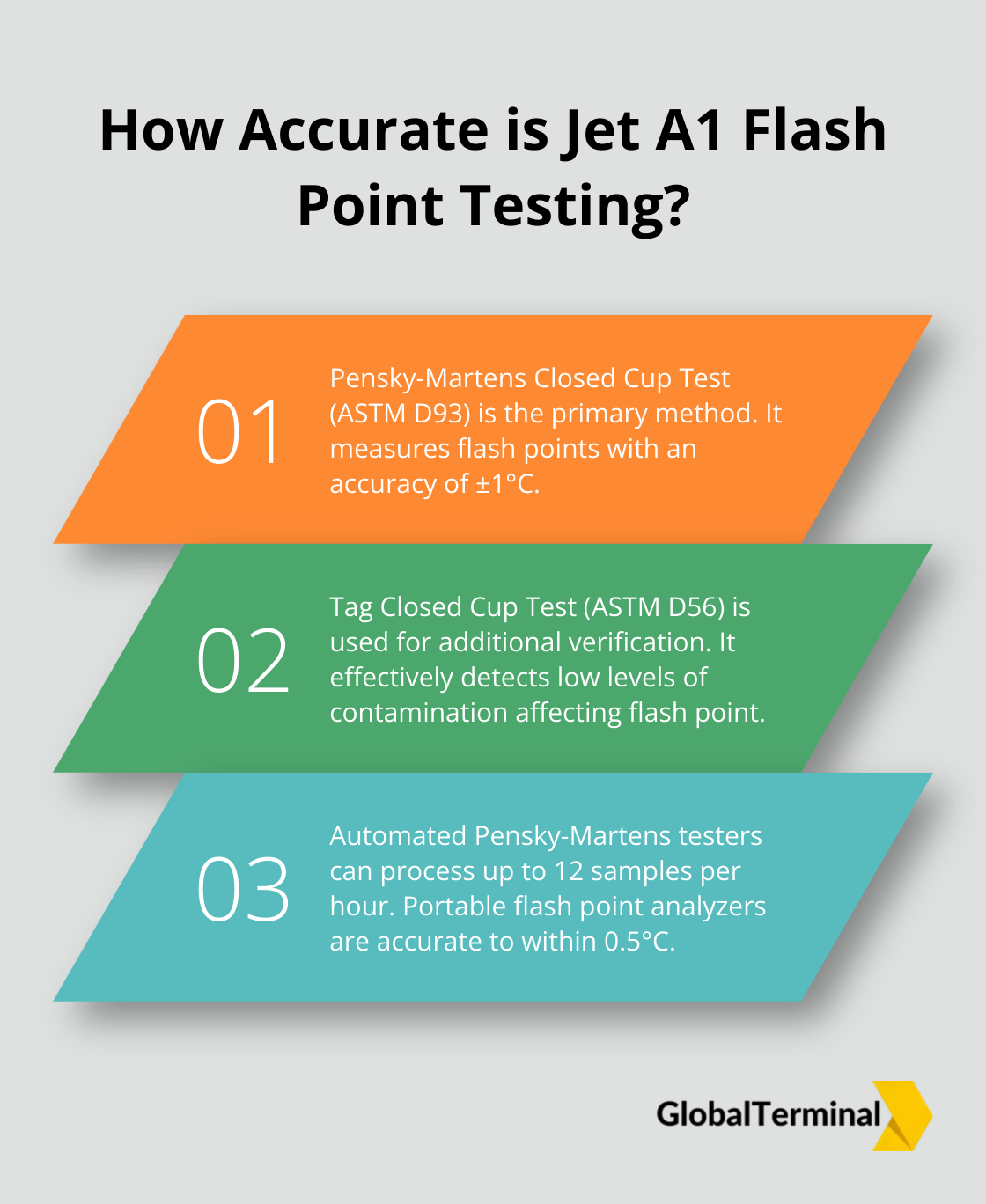
Technicians also use the Tag Closed Cup Test (ASTM D56) for additional verification. This method effectively detects low levels of contamination that might affect flash point. These tests can measure flash points with an accuracy of ±1°C, which is essential for maintaining the 38°C minimum standard for Jet A1.
Frequent Quality Checks
Flash point tests occur at multiple stages of the fuel handling process. Every batch of Jet A1 undergoes immediate testing upon receipt at terminals. Daily checks for fuel in storage are standard practice in the industry.
Additional tests take place before distribution to ensure no changes have occurred during storage. This frequency allows for quick detection of any deviations, preventing off-spec fuel from entering the supply chain.
Cutting-Edge Equipment
Testing facilities use automated Pensky-Martens testers that provide rapid and accurate results. These machines (calibrated to National Institute of Standards and Technology specifications) can process up to 12 samples per hour, allowing for comprehensive quality control.
Portable flash point analyzers enable on-site testing at various points in the distribution network. These devices (accurate to within 0.5°C) allow for real-time quality assurance and rapid response to any potential issues.
Emerging Technologies
The aviation fuel industry continues to innovate in flash point monitoring technology. Recent developments include continuous monitoring systems that can detect flash point changes in real-time during fuel transfers. While not yet widely implemented, these systems show promise for further enhancing safety in fuel handling operations.
Industry Standards and Compliance
Adherence to international standards is paramount in Jet A1 flash point testing. Organizations like ASTM International and the Energy Institute regularly update testing protocols to ensure consistency across the industry. Compliance with these standards is mandatory for all fuel handlers and distributors.
Regular audits and certifications from regulatory bodies help maintain the integrity of testing procedures. These audits often include blind sample testing to verify the accuracy of equipment and technician competence.
Final Thoughts
The Jet A1 flash point is a critical safety parameter in aviation fuel handling. Regular testing with approved methods and strict adherence to storage guidelines help preserve flash point integrity. The aviation fuel industry continues to innovate, with promising developments in continuous monitoring systems for real-time detection of flash point changes during fuel transfers.
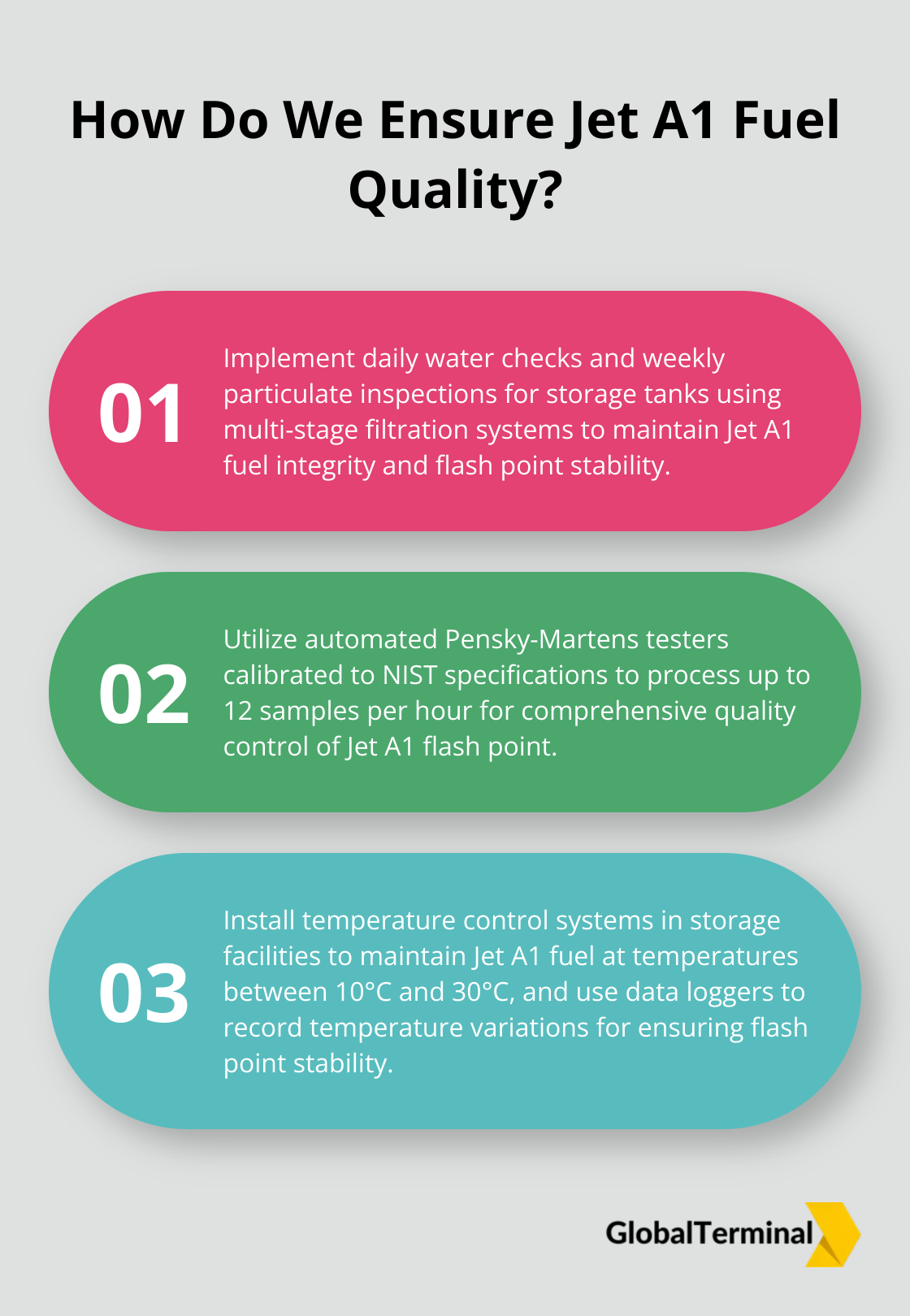
At GLOBAL TERMINAL NETHERLANDS B.V, we prioritize fuel safety and quality in our operations. Our facilities in strategic global ports aim to maintain the critical safety properties of Jet A1 fuel throughout storage and distribution. We combine technology with experienced professionals to provide reliable fuel storage and logistics solutions.
The methods and technologies used to monitor and maintain Jet A1 flash point will evolve as the aviation industry progresses. This commitment to safety and innovation will support the growth and reliability of global air travel. Flash point will remain a key safeguard in aviation fuel handling for years to come.


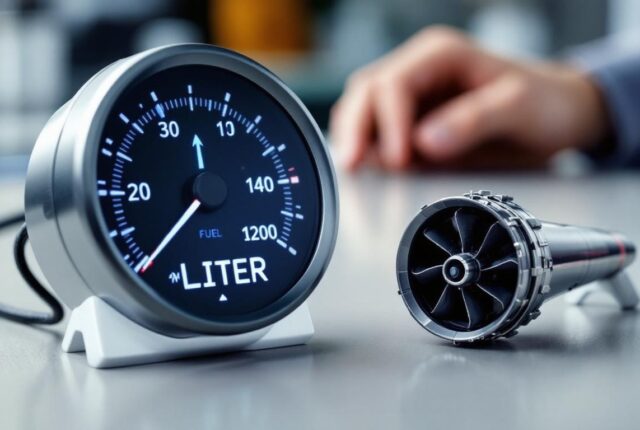


Leave a Reply